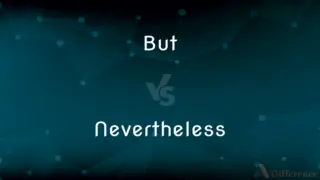Epicycloid vs. Hypocycloid — What's the Difference?
By Tayyaba Rehman — Updated on August 1, 2023
An epicycloid is traced by a point on the circumference of a circle rolling outside another circle, while a hypocycloid is traced by a point on a circle rolling inside another circle.

Difference Between Epicycloid and Hypocycloid
Table of Contents
ADVERTISEMENT
Key Differences
An Epicycloid is a curve traced by a point on the rim of a circular wheel rolling along the outside of another circle, while a Hypocycloid is a curve generated by a point on the rim of a smaller circle that rolls inside a larger fixed circle.
In an Epicycloid, the rolling circle moves along the outside of the fixed circle, creating loops or petals that are often more complex and elongated; in a Hypocycloid, the rolling circle moves inside the fixed circle, leading to shorter, sharper curves.
The number of cusps (sharp points) or loops in an Epicycloid depends on the ratio of the radii of the rolling and fixed circles, whereas the Hypocycloid's shape depends on the same ratio, but it often results in fewer, more compact cusps or loops.
Epicycloids are utilized in various fields, including gear design for smooth transmission of motion; Hypocycloids, on the other hand, are also used in gears and have applications in certain types of engines called Wankel engines.
While both Epicycloids and Hypocycloids can be visually stunning and are often studied for their mathematical properties, Epicycloids tend to exhibit a more flower-like appearance, whereas Hypocycloids often resemble star-like shapes or even straight lines in certain cases.
ADVERTISEMENT
Comparison Chart
Definition
A curve traced by a point on the rim of a circular wheel rolling outside another circle.
A curve traced by a point on the rim of a circular wheel rolling inside another circle.
Equation
If the larger circle has radius RR and the smaller one has radius rr, the parametric equations are x = (R + r)\cos t - r\cos\left(\frac{R + r}{r}t\right)x=(R+r)cost−rcos(rR+rt) and y = (R + r)\sin t - r\sin\left(\frac{R + r}{r}t\right)y=(R+r)sint−rsin(rR+rt).
If the larger circle has radius RR and the smaller one has radius rr, the parametric equations are x = (R - r)\cos t + r\cos\left(\frac{R - r}{r}t\right)x=(R−r)cost+rcos(rR−rt) and y = (R - r)\sin t - r\sin\left(\frac{R - r}{r}t\right)y=(R−r)sint−rsin(rR−rt).
Cusps
The number of cusps is determined by the ratio of the radii, and it has as many cusps as the number of times the smaller circle rolls around the larger circle.
The number of cusps is determined by the ratio of the radii, and it has as many cusps as the number of times the smaller circle rolls inside the larger circle.
Graphical Appearance
Epicycloids often resemble a series of arches or waves outside the circle, depending on the ratio of radii.
Hypocycloids often resemble a series of pointed stars or petals inside the circle, depending on the ratio of radii.
Special Cases
A specific form of epicycloid, when R = rR=r, is a cardioid.
A specific form of hypocycloid, when R = 3rR=3r, is called an astroid.
Compare with Definitions
Epicycloid
In geometry, an epicycloid is a plane curve produced by tracing the path of a chosen point on the circumference of a circle—called an epicycle—which rolls without slipping around a fixed circle. It is a particular kind of roulette.
Hypocycloid
In geometry, a hypocycloid is a special plane curve generated by the trace of a fixed point on a small circle that rolls within a larger circle. As the radius of the larger circle is increased, the hypocycloid becomes more like the cycloid created by rolling a circle on a line.
Epicycloid
A curve traced by a point on the circumference of a circle that rolls without slipping around the outside of a fixed circle.
The spirograph toy produces beautiful patterns, including epicycloids, as the small cog rolls around the larger one.
Hypocycloid
A curve that can be described using trigonometric functions, representing the path of a point on a smaller circle inside a larger one.
The student utilized a graphing calculator to explore the characteristics of a hypocycloid for his project in geometry class.
Epicycloid
A plane curve generated by the motion of a point on the circumference of a smaller circle that rolls externally on a larger circle.
The epicycloid is formed when the radius of the larger circle is three times that of the smaller rolling circle.
Hypocycloid
A special curve generated by the path of a fixed point on a smaller circle that rolls inside a larger circle.
The mathematician analyzed the hypocycloid's properties to determine its applications in engineering.
Epicycloid
(geometry) The locus of a point on the circumference of a circle that rolls without slipping on the circumference of another circle.
Hypocycloid
The plane locus of a point fixed on a circle that rolls on the inside circumference of a fixed circle.
Epicycloid
A curve traced by a point in the circumference of a circle which rolls on the convex side of a fixed circle.
Hypocycloid
A line generated by a point on a circle that rolls around inside another circle.
Epicycloid
The curve described by a point on the circumference of a circle as the circle rolls on the outside of the circumference of a second, fixed circle.
Hypocycloid
(geometry) The locus of a point on the circumference of a circle that rolls without slipping inside the circumference of another circle.
Epicycloid
A mathematical curve defined by the parametric equations \( x = (R + r) \cos \theta - r \cos \left(\frac{R + r}{r}\theta\right) \) and \( y = (R + r) \sin \theta - r \sin \left(\frac{R + r}{r}\theta\right) \), where \( R \) and \( r \) are the radii of the larger and smaller circles respectively.
The geometry class studied the equations of an epicycloid to understand how the radii of two circles could create such an intriguing pattern.
Hypocycloid
A curve traced by a point in the circumference of a circle which rolls on the concave side in the fixed circle.
Epicycloid
A line generated by a point on a circle rolling around another circle.
Hypocycloid
A curve defined by specific parametric equations, often associated with the motion of gears.
In mechanical systems, the shape of a hypocycloid can be found in the way certain gears mesh together.
Epicycloid
A specific type of roulette curve described by a smaller circle that rolls along the outside of a fixed, larger circle.
By adjusting the size of the rolling circle in relation to the fixed circle, you can create a variety of epicycloid shapes.
Hypocycloid
A curve traced by a point on the radius of a circle as it rolls along the inside of another circle.
By using a spirograph, children can create intricate designs that include shapes like hypocycloids.
Epicycloid
A curve often used in mechanical design, created by the path of a point on the rim of a circular gear as it rolls around the outside of another gear.
Engineers in the automotive industry might use epicycloids in the design of gear systems for efficient power transmission.
Hypocycloid
A type of roulette traced by a point attached to a circle rolling inside another circle without slipping.
The hypocycloid formed a beautiful pattern, inspiring the artist to incorporate it into her artwork.
Common Curiosities
What is the difference between epicycloid and hypocycloid?
An epicycloid is traced by a point on a circle that rolls on the outside of another fixed circle, whereas a hypocycloid is traced by a point on a circle that rolls on the inside of another fixed circle.
What is a cycloid and epicycloid?
A cycloid is a curve traced by a point on a circle's rim as it rolls along a straight line, and an epicycloid is a similar curve but formed by a point on a smaller circle's rim rolling around the outside of a larger, fixed circle.
What is cycloid, epicycloid, and hypocycloid?
A cycloid is the curve traced by a point on a circle's rim as it rolls along a straight line. An epicycloid is a curve formed by a point on a smaller circle's rim rolling around the outside of a larger, fixed circle. A hypocycloid is a curve formed by a point on a smaller circle's rim rolling inside a larger, fixed circle.
How do you draw a hypocycloid?
To draw a hypocycloid, trace the path of a point on a circle as it rolls on the inside of a fixed circle using geometric tools or mathematical software with the correct equations.
What are the types of epicycloid?
Types of epicycloids include simple epicycloids with various numbers of cusps or loops and complex epicycloids created with different radii ratios between the rolling and fixed circles.
What are the applications of cycloid, epicycloid, and hypocycloid?
Cycloids, epicycloids, and hypocycloids have various applications in physics, engineering, and mathematics, including the design of specific types of gears, the study of motion, and geometric demonstrations.
What are the applications of epicycloid?
Epicycloids are used in various fields like mechanical engineering to design specific types of gears and in mathematics for certain geometric studies and demonstrations.
How do you draw a hypocycloid in engineering graphics?
Drawing a hypocycloid in engineering graphics requires understanding the mathematical properties and using appropriate tools or software to trace the path of a point on a rolling circle inside a fixed circle, often using parametric equations.
What is an example of epicycloid?
A classic example of an epicycloid is the shape created by drawing a smaller circle rolling around the outside of a larger circle, such as the shape that's sometimes seen in mechanical gears.
What is the difference between Hypotrochoid and hypocycloid?
A hypocycloid is a special case of a hypotrochoid where the tracing point is on the circumference of the rolling circle. A hypotrochoid is traced by a point attached to a circle rolling inside a fixed circle, but the point doesn't have to be on the circumference.
What is the area of the hypocycloid?
The area of a hypocycloid can be found by integrating the curve's equation over one complete period using appropriate mathematical techniques.
What is the length of the epicycloid?
The length of an epicycloid can be determined by integrating the distance formula over one complete period of the curve using the parametric equations for the epicycloid.
What is the special case of epicycloid?
A special case of an epicycloid is when the rolling circle's radius is half that of the fixed circle, resulting in a curve known as a Cardioid.
How do you construct an epicycloid and hypocycloid?
An epicycloid and hypocycloid can be constructed by tracing a point on a circle as it rolls on the outside (epicycloid) or inside (hypocycloid) of another fixed circle.
How do you make an epicycloid?
You can make an epicycloid by tracing the path of a point on a circle as it rolls on the outside of a fixed circle. This can be done with geometric tools or using mathematical software with appropriate equations.
What is the hypocycloid mechanism?
The hypocycloid mechanism refers to the geometric principles or machinery that utilize the properties of a hypocycloid, often found in engineering applications like gear design.
What is a three cusped hypocycloid?
A three cusped hypocycloid is a specific type of hypocycloid that is formed when the rolling circle's radius is one-third the size of the fixed circle's radius, resulting in a curve with three distinct loops or cusps.
How do you find the arc length of a hypocycloid?
The arc length of a hypocycloid can be found by integrating the distance formula over one complete period of the curve using the parametric equations for the hypocycloid.
What is the general form of the hypocycloid?
The general form of a hypocycloid refers to its mathematical representation, typically expressed through parametric equations involving the radii of the fixed and rolling circles.
Is epicycloid the locus of a point on the circumference?
Yes, an epicycloid is the locus of a point on the circumference of a rolling circle as it moves around the outside of a fixed circle.
How do you find the angle of an epicycloid?
The angle of an epicycloid at a specific point can be found by taking the derivative of the curve's equations and using trigonometric functions to calculate the angle at that point.
What is the structure of epicycloid?
The structure of an epicycloid consists of a series of arcs, known as cusps, that are connected to each other and formed by a point on the circumference of a circle rolling around the outside of a larger fixed circle.
What is the definition of hypocycloid?
A hypocycloid is a curve traced by a point on the rim of a circle rolling on the inside of another fixed circle.
What is the equation for the epicycloid?
The parametric equations for an epicycloid are given by \( x = (R + r) \cos t - r \cos \left(\frac{{R + r}}{{r}}t\right) \) and \( y = (R + r) \sin t - r \sin \left(\frac{{R + r}}{{r}}t\right) \), where \( R \) is the radius of the fixed circle and \( r \) is the radius of the rolling circle.
What is the period of a hypocycloid?
The period of a hypocycloid is the length of one complete cycle of the curve, and it depends on the radii of the fixed and rolling circles.
What is the parametric equation of a hypocycloid?
The parametric equations for a hypocycloid are given by \( x = (R - r) \cos t + r \cos \left(\frac{{R - r}}{{r}}t\right) \) and \( y = (R - r) \sin t - r \sin \left(\frac{{R - r}}{{r}}t\right) \), where \( R \) is the radius of the fixed circle and \( r \) is the radius of the rolling circle.
What are the conditions for a hypocycloid to be a straight line?
A hypocycloid becomes a straight line when the radius of the rolling circle is a simple fraction of the fixed circle's radius, such as when the radius of the rolling circle is one-third the size of the fixed circle.
How do you draw a tangent to an epicycloid?
A tangent to an epicycloid can be drawn by finding the derivative of the curve at a specific point and using that slope to draw the tangent line at that point.
What is the history of epicycloid?
The epicycloid has a rich history dating back to the 17th century and has been studied by many mathematicians, including Mersenne and Wren. It has been applied in various fields like mechanical engineering and mathematical studies.
How do you draw an epicycloid of a circle?
Drawing an epicycloid of a circle involves tracing the path of a point on a smaller circle as it rolls around the outside of a larger, fixed circle. This can be done using geometric tools or mathematical software with appropriate equations.
Share Your Discovery

Previous Comparison
Dehydration vs. Desiccation
Next Comparison
But vs. NeverthelessAuthor Spotlight
Written by
Tayyaba RehmanTayyaba Rehman is a distinguished writer, currently serving as a primary contributor to askdifference.com. As a researcher in semantics and etymology, Tayyaba's passion for the complexity of languages and their distinctions has found a perfect home on the platform. Tayyaba delves into the intricacies of language, distinguishing between commonly confused words and phrases, thereby providing clarity for readers worldwide.















































